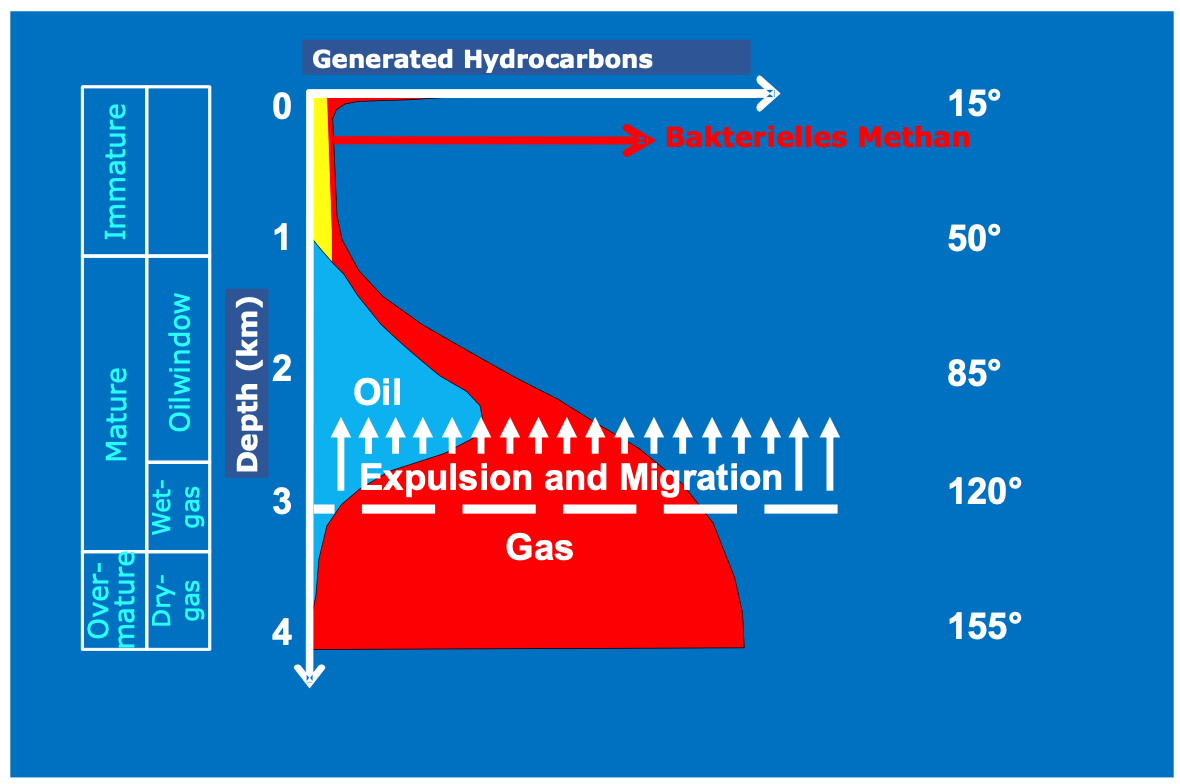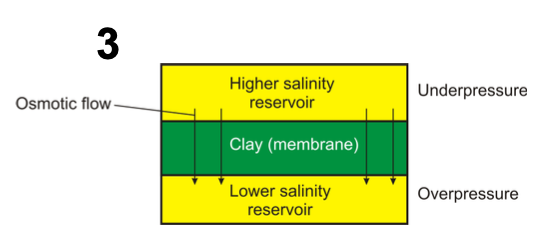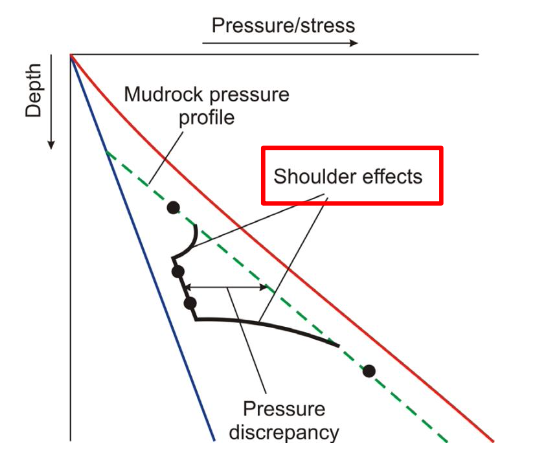petroleum geology
1/71
There's no tags or description
Looks like no tags are added yet.
Name | Mastery | Learn | Test | Matching | Spaced |
|---|
No study sessions yet.
72 Terms
petroleum system
Source rock (where oil forms),
Reservoir rock(where oil is stored),
Seal rock(rock layer that traps oil),
Overburden rock (geological structure that holds oil),
And the processes like trap formation & generation-migration-accumulation.
sedimetary basin
accumulation space for sedimentary rocks that can contain oil and gas reservoirs defined by
prospect = A specific site (single deposit) where oil might be drilled.
play = series of genetically linked accumulations
burial history chart

oil window
the depth/temperature range where oil is generated.
critical moment
the point in time when hydrocarbons reach the trap — vital for assessing whether oil will be present.
Total Organic Carbon (TOC)
a key measure of how much organic material is in a rock.
>0.6% for carbonates.
>1.0% for mudstones/shales.
=> Rocks with >2.0% TOC are very promising for oil generation.
generation process
Accumulation: Trapped in suitable reservoir structures.
Migration: They move through porous rocks.
Generation: Oil/gas form from organic matter.
reservoir routine analysis
Fluid saturation: How much oil/water is in the pores?
Oil traces: Detected using fluorescence under UV light.
Porosity measurements: How much empty space is in a rock for oil to be stored
flooding the sample w/ He, H2O or Hg
Permeability measurements: producibility of fluids
seal
rock formation that is impermeable and laterally continuous. Holds back hydrocarbons from further migration (to the surface).
petroleum systems classification
charge factor → how much can be generated
supercharges
normally charged
undercharged
drainage style → direction & range of migration
laterally drained
vertically drained
entrapment style → how much can accumulate
high impedence
low impedance
typicality
crude oil composition
aliphatic HC
saturated HC
linear: normal paraffin series = n-alkanes
branched: iso-paraffin series = iso-alkanes
rings: naphthene series = cycle-alkanes
unsaturated HC → double/ triple c-c bonds
aromatic HC: Organic compounds which consist only of C and H and contain one or more benzene rings
pure aromatics
cyclo-alkano-aromatics
cyclic sulfur
heterocompounds (NSO-compunds): organic compounds which consist of one/more atoms other tan HC e.g. resins & asphaltenes
gas classification
composition
dry gas → <5% ethane
wet gas → >5% ethane
sour gas → contains sig. amount of H2S along H2, He & Ar
acid gas → contains sig. amount of H2S & CO2
isotopy
light gas
heavy gas
origin of HC
bacterial: produced by bacteria from organic matter in sediments (incl. coal) or liquids at low temperatures (<80°C) → isotopically light & dry
primary: produced by bacteria from organic matter in sediments
secondary: produced by anaerobic bacteria from liquid petroleum
=> depending on the degree of anaerobic biodegradation
thermogenic: produced by thermal processes from organic matter in sediments or liquid petroleum → isotopically heavy & wet
associated: petroleum gas associated with/ oil
non-associated: formed at temp. where liquid petroleum is no longer stable
=> depending on the temp of gas formation (thermal maturity)
oil alteration in reservoir processes
biodegradation → Produces secondary microbial methane
water washing
de-asphalting
thermal cracking → Produces thermal gas by„secondary cracking“
crude oil biodegradation
Aerobic: Fast, usually where oxygenated meteoric water enters the reservoir.
Anaerobic: Relatively slow (x-xx my). End product may be methane (secondary bacterial gas). Bacterial sulfate reduction may produce free H2S.
>80°C starting at OWC

biodegradation effects on oil
decrease oil quality
reduces API gravity
raises viscosity, sulphur content, asphaltenes %
Increases acidity (adds carboxylic acids)
biodegradation effects on thermogenic gas
Increase in i-C4/n-C4 ratio (microbes prefer n-alkanes)
Increase in C2/C3 ratio (microbes prefer C3 → easier to remove C atom)
Gas drying (microbes produce CH4)
Produces isotopically light methane (d13C < -40 ‰
Produces isotopically heavy CO2 (d13 > +5 ‰ → fractionation light (CH4)– heavy (CO2)
water washing
HC undersaturated meteoric waters dissolve light HCs from reservoired petroleum →density increases
de-asphalting
Precipitation of heavy asphaltene compounds often resulted from injection of light (C1-C6) HCs
de-asphalting causes
Gravitational segregation from free oil column
Biodegradation-induced asphaltene preciptiation
In-reservoir maturation-induced asphaltene preciptiation
Pressure reduction-induced asphaltene precipitation (migration, uplift)
Adsorption onto clay minerals (kaolinite!)
thermal alteration results
„Secondary“ oil cracking →produces condensate, wet gas and finally dry gas
Increase in volume
isolated system → pressure increase (seal failure?)
open system → possibly loss of HCs
Produces pyrobitumen (solid residue)
unconventional HC products
Tar Sand (Oil Sand)
Tight Gas & Tight Oil: O&G in low permeable res rock → acidizing, fracking, tensides
Shale Gas & Shale Oil: O&G produced directly from extremely low permeable source rock (nD-range) → fracking and horizontal drilling
Coalbed Methane: gas absorbed to cal substance → de-watering & fracking
Gas-hydrate (Clathrate): „ ice“ composed of gas molecules within water cage
Oil Shale: Organic matter-rich (but thermally immature!) rock which yields significant amounts of oil and gas during low-temperature pyrolysis
petroleum data sources
boreholes
cuttings/ cavings: small rock fragments created during drilling, and transported to the surface by the drilling mud
cores
geophysical data
wireline logs
seismics
gravimetry
magnetics
outcrop analogues
cuttings preparation
retrieve drill cuttings from the mud system
cloth bag the bulk, unwashed wet cut samples
paper bag washed & sieved dry cut samples → examined under binoculars
cuttings benefits
continus visuels record
shows evaluation of HC
describes reservoir and lithological
Geological correlation and formation identification
rock type
lithology
grain shape/size/ sorting
porosity
hardness
cementation/ matrix
Verification of wireline log response
Design of strip logs (lithology vs. depth).
cuttings problems
Excess weight on bit → powder
Insufficient mud viscosity → cuttings are not transported to surface (deviated wells!)
Improper mud chemistry → high % cavings, selective mineral dissolution, contamination
Contamination by cavings
Exact depth a ign ent “lag time” ->accuracy 2-5 m at best!
cores benefits
in physical contact w/ the res
allows direct measurement of physical properties
allows direct observation of grain size/ sorting & sedimentary structures → depositional environment interpretation
allows calibration to logs
routine core analysis
Lithologic Description
Fluid Saturation
Porosity
Permeability
Grain Density
Core Gamma Log
special core analysis
Electrical Properties
Acoustic Properties
Compressibility
Wettability
Capillary Pressure
Two-phase flow tests
porosity
the amount of void space in a sample capable of holding fluid
porosity factors
packing
sorting
grain shape/ size
degree of cementation
growth of clay minerals
mineral dissolution
porosity measurements
volumetric
mercury intrusion (MICP)
water imbibition
gas expansion
imaging
optical microscopy
µCT
FIB/BIB-SEM
permeability factors
grain size/shape
sorting
distribution of pore channels
pore occlusion
wettability
the contact angle Q between a droplet of liquid and a horizontal surface
wetting: 0-90°
non-wetting: 90-180°
relative permeability
the percentage (or decimal) of the total permeability of the rock to that one of the multiple fluids
effective permeability
the permeability of the rock to any one of the fluids
EOR usage
mature fields
tight reservoirs
wireline logs
Correlation logs
Spontaneous Potential (SP)
Gamma Ray
Resistivity logs
Porosity logs
Sonic Log
Density Log
Neutron Log
Dipmeter
Cased hole logs
caliber log usage
Borehole condition
Formation properties (mud cake → permeable zone, fracture zones)
Borehole volume → cementation
reasons of diff logging resolutions
Fundamental physicochemical processes that cause logging signal
Geometry of the logging device
Logging speed
spontaneous potential
measures the natural battery effect that occurs at the interface where foreign ions (drilling fluid) enter porous zones and are juxtaposed against normal fluids in non-porous zones.
gamma ray
Measures natural radioactivity (U, Th, 40K)
spectral gamma ray interpretation
High Th values:
increase in terrigenous clays (smectite, kaolinite)
heavy minerals
High U values:
increased organic carbon → source rocks „hot shale“
hot dolomite (U enrichment)
High K values:
Glauconite (mineral in green sandstones, shallow marine deposition)
resistivity logs usage
determine HC vs. water-bearing zones
indicate permeable zones
determine resistivity porosity
resistivity logs classification
induction logs → measures conductivity
electrode logs → measure resistivity
sonic log
measures interval transit time (∆t →DT) of acoustic waves over discrete distances. ∆t is a function of lithology and F (∆detf).
density log process
Emits medium-energy gamma rays and measures returning gamma ray energies
Gamma rays are scattered (Compton scattering) as a result of collisions with electrons in the formation
cased hole logs
GR
neutron log
pulsed neutrinos log
bright spot
amplitude anomaly caused by a large gas reservoir
increase in velocity and density contrast
high amplitude
thermal conductivity relations
decreases w/ porosity
increases w/ burial depth
decreases in GG w/ depth and increases with saturation.
overpressure generating mechanisms
by loading
disequilibrium compaction
tectonic compression → Murdock cannot dewater fast enough for the pore fluid to remain in hydrostatic equilibrium as it compacts
by unloading: load transfer from grain to grain contacts to the pore fluid
influx of pore fluid
conversion of solid matrix material into fluids = OM conversion/ mineral diagenesis
HC buoyancy: the pore water in the water saturated reservoir is at normal hydrostatic pressure
hydraulic head: The maximum head (H) due to this mechanism is equal to the elevation of the reservoir at outcrop,
osmosis

shoulder effect
anomalous overpressure zones that occur at the margins of thick, undercompacted, or low-permeability source rock layers.

pore overpressure factors
storage pores
connecting pores
results of unloading in Mudrock
Elastic opening of connecting pores → strongly affects sonic log
Only very small increase in total ø → nearly no effect in density log
underpressure generating mechanisms
Reservoir depletion during HC production
Relatively isolated sand bodies in the recharge area compared to the discharge area
plate boundaries
divergent → spread away
rift basins
mid ocean ridges
convergent → one plate submerge underneath another
subduction
continent-continent collision
transform → slide past each other
strike-slip basin
divergent setting
intercontinental sag → large oval shaped, slowly subsiding, long lived basins resulted from thermal contraction, eclogitization of lowermost crust &/or intraplate stress
graben structure = rift basin → Narrow elongate basins which result from crustal stretching
syn-rift phase: During early rifting many basins are overfilled with fluvial sediments, but may later become underfilled
post-rift phase: After crustal stretching sediments often overlie syn-rift deposits with an unconformity and tend to be
more uniform
passive continental margins → very thick sediment successions
intercontinental sag characteristics
thinning sediments towards the basin margins
no major faults
continental, lacustrine/ shallow marine sediments
controlled by sea lvl variations
low GG
contain large amount of HCs
e.g. Michigan basin
graben structure characteristic
syn-rift phase:
lacustrine shales
evaporite deposits
numerous normal faults & tilting of fault blocks
crustal thinning = high q = high GG
post-rift phase
gradual heat flow decrease
host HC deposits
e.g. North Sea
passive continental margin characteristics
deeper part of syn-rift
normal faulting
often lacustrine source rocks
salt domes
post-rift
controlled by prograding delta sequences &/or carbonate platforms
slope shows historic growth faults, rollover structures & mud diapers
show long lasting subsidence trends due t cooling & sediment loading
e.g. margins of Atlantic ocean
convergent settings
subduction
fore-arc basin → between island arc & accretionary wedge
back-arc basin → on oceanic crust
retro-arc foreland basin → on continental crust behind an arc w/ a fold-thrust-belt
continent-continenet collision
remnant basin → Narrowing ocean basin filled mainly with turbidites
peripheral foreland basin → asymmetric basin mainly controlled by the load of the advancing overthrust belt
fore-arc basin characteristics
source rock: organic rich sediments
very low GG → bacterial gas
deltaic sediment/ shallow marine sediments
back arc basin
may be a good oil region
supply sediment from deltaic & shallow marine
peripheral foreland basin characteristics
filled w/ molasses deposits
trend form deep marine to continental & from distal fine grained to proximal coarse grained sedimentation
low GG
compressional structure & over pressuring
e.g. north alpine basin
piggy back basin
deposited on thrust sheets & transported passively on top of the thrusts
Sedimentary material mainly from the thrust belt → Low preservation potential (only in young orogens)
e.g. po basin
strike-slip basin (transform setting)
Narrow basins with variable length
Extremely fast subsidence
Structurally complex
Usually short-lived
e.g. Vienna basin
source rock parameters
amount of OM
type of OM
kerogen → insoluble in organic solvents
bitumen → soluble in organic solvents
thermal maturity
kerogen characterisation
Elemental analysis → determine C,H, O contents
categorised based on H-content from type I = H- rich = high H/C & type III = H-poor = low H/C
Pyrolysis (RockEval pyrolysis)
Pyrolysis-GC → Investigation of the chemical composition of
the pyrolysate
Microscopy (petrography) → determines macerals
reflected light (normal + fluorescent)
transmitted light
SEM → characterisation of OM in source rocks
correlative light & scanning electron microscopy
bitumen characterisation
gas chromatography/ mass spectrometry (GC/MS)
isotopy